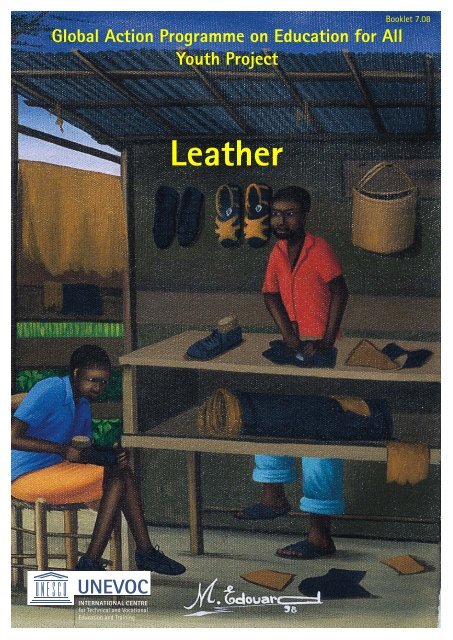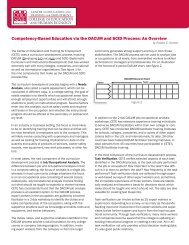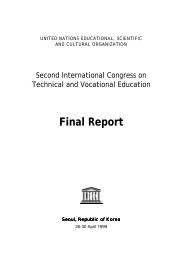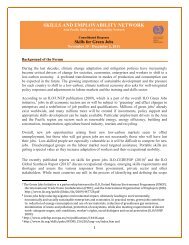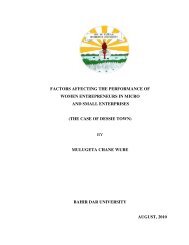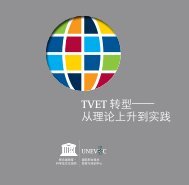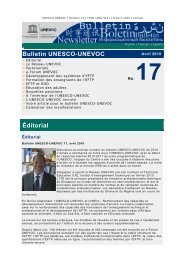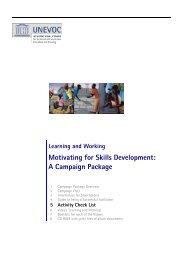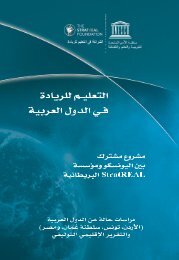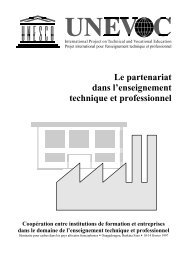Leather - Unesco-Unevoc
Leather - Unesco-Unevoc
Leather - Unesco-Unevoc
Create successful ePaper yourself
Turn your PDF publications into a flip-book with our unique Google optimized e-Paper software.
Booklet 7.08<br />
Global Action Programme on Education for All<br />
Youth Project<br />
<strong>Leather</strong>
Learning and Working<br />
Motivating for Skills Development:<br />
A Campaign Package<br />
Version February 2006<br />
1 Campaign Package Overview<br />
2 Campaign Flyer<br />
3 Information for Stakeholders<br />
4 Guide to being a Successful Facilitator<br />
5 Activity Check List<br />
6 Videos ‘Learning and Working’<br />
7 Booklets for each of the Videos<br />
8 CD-ROM with print files of above documents
Page 1 <strong>Leather</strong> Page 1<br />
Booklet 7.08 - LEATHER<br />
This booklet complements the video clip on “<strong>Leather</strong>” on DVD 2. It gives a short summary of the content of<br />
the video and contains illustrations followed by technical texts, which will make it easier to understand<br />
and recall the activities shown in the video. The booklet can be copied and handed out to participants, so<br />
that they can make notes on them or use them as a reference for later.<br />
A transcript of the soundtrack of the video is included at the back of the booklet. Whenever the locally<br />
spoken language is different from the language used in the video, the facilitator may wish to use this text<br />
transcript as a basis for comments and explanations in the local language.<br />
Comment and Observations<br />
The video shows very specialised trades which require skills that are not easily learned. The facilitator<br />
should be able to provide information on where to obtain further training on the processing of leather. The<br />
facilitator has to attach importance to occupational health and safety topics.<br />
Occupational Health and Safety<br />
The process of tanning, especially mineral tanning, can be harmful to both the worker and the<br />
environment, if not carried out safely and correctly. The worker should wear protective clothing, protective<br />
gloves and shoes as well as a respirator to avoid breathing in dust and spray mists.<br />
The facilitator should point out that the working environment shown in the video, where the workers can<br />
be seen to work with bare hands, is not acceptable.<br />
Video LEATHER: Summary<br />
Animal hides can be turned into leather. The video shows the processes by which this is achieved and also<br />
demonstrates the use of leather in producing shoes, sandals and leather masks. The work is usually done by<br />
men and requires tools to cut leather. It should be noted that the activities shown presuppose good<br />
understanding and knowledge of the work as well as good skills in working with leather.
Page 2 <strong>Leather</strong> Page 2<br />
Notes:
Page 3 <strong>Leather</strong> Page 3<br />
Notes:
Page 4 <strong>Leather</strong> Page 4<br />
Notes:
Page 5 <strong>Leather</strong> Page 5<br />
Notes:
Page 6 <strong>Leather</strong> Page 6<br />
Notes:
Page 7 <strong>Leather</strong> Page 7<br />
Notes:
Page 8 <strong>Leather</strong> Page 8<br />
Notes:
Page 9 <strong>Leather</strong> Page 9<br />
Notes:
Page 10 <strong>Leather</strong> Page 10<br />
Notes:
Page 11 <strong>Leather</strong> Page 11<br />
Notes:
Page 12 <strong>Leather</strong> Page 12<br />
Notes:
Page 13 <strong>Leather</strong> Page 13<br />
Notes:
Page 14 <strong>Leather</strong> Page 14<br />
Video LEATHER: Technical Information<br />
Some General Points about <strong>Leather</strong><br />
Since the beginning of times, human beings have<br />
used leather to make clothes. In the course of the<br />
millenniums we have learned to make other<br />
products with leather, for example, containers to<br />
transport water or wine, boats, tents and objects of<br />
art. One usually uses the skin of cows, sheep, pigs,<br />
horses, goats or games. <strong>Leather</strong> is a beautiful<br />
material and very resistant.<br />
If you want to work with leather, you require a<br />
good knowledge of the work, imagination, patience<br />
and also preciseness.<br />
It is advisable to learn the profession from a<br />
craftsman, who is also able to teach you the art of<br />
shoe making.<br />
The tanning<br />
<strong>Leather</strong> is made of animal skins that are preserved<br />
through a chemical treatment called tanning.<br />
Tanning prevents the skins from decomposing,<br />
drying out or rotting when they get in contact with<br />
water.<br />
In the ancient times, tanning with fat was usual,<br />
but today, people focus on two kinds of tanning:<br />
vegetable tanning and mineral tanning.<br />
In both processes of tanning, the skins have to<br />
undergo a preliminary treatment, in which all hair<br />
is taken off the outer surface, and all the connective<br />
and muscular tissues taken off the inner part.<br />
Vegetable tanning has been in use since 3000 years<br />
before Christ. In Egypt, until the 19 th century, it<br />
was considered the most important process of<br />
tanning.<br />
In this process, you use a mixture based on water<br />
and grounded barks (barks of oaks, chestnut trees<br />
or fir trees in Europe or barks of mango trees in<br />
Haiti).<br />
The tree barks contain a chemical matter called<br />
tannin. The leather, preliminarily soaked into water<br />
and lime, has to stay up to three weeks in this<br />
infusion. After that, it is rinsed in clean water and<br />
let to dry. This way, sturdy and very water resistant<br />
leather is obtained.<br />
Mineral tanning was practised by the Chinese 2000<br />
years ago. Since the 19 th century, the modern age,<br />
salts of chromium, aluminium or zirconium have<br />
been used. With these products, you can reduce the<br />
rinsing time by few days, but you will obtain<br />
leather that is particularly soft and supple.<br />
Cutting the leather<br />
It’s quite difficult to cut a precise line into the<br />
leather. Therefore, it’s always advisable to use a<br />
pattern or a ruler. You can achieve round forms or<br />
straight lines by pressing regularly on the knife.<br />
Getting the leather thinner<br />
Before sewing cut pieces of leather together, for<br />
example to make shoes, you have to make the sides<br />
thinner so that the sewn parts have the same<br />
thickness as the rest.<br />
To do this, you have to use a knife, held diagonally,<br />
to make the borders of the inside of the leather, the<br />
flesh side, thinner.<br />
<strong>Leather</strong> shoes<br />
All of these work steps are also necessary for<br />
making shoes. You need supple, tanned leather.<br />
With the help of a pattern you cut out the pieces<br />
for the shoes, the two lateral parts and the<br />
buttress. Then, make the sides of the pieces thinner<br />
before you assembly them. Put glue on the thin<br />
sides and let them dry for a short time. Then, the<br />
thin sides can be curved and slightly hammered.<br />
The sides are sturdy enough to be sewn together.
Page 15 <strong>Leather</strong> Page 15<br />
Folding and modelling leather<br />
You can fold or model any leather to form waves,<br />
for example. You can also cut them into strips and<br />
turn them to spirals; for that, you first have to<br />
slightly moisten the exterior side. You will fold it<br />
inside. Once folded to the desired form, let the<br />
work dry. This way, the leather will get hard and<br />
maintain its form.<br />
Punching leather<br />
You make holes for shoelaces or belts either with a<br />
nail or with a pair of professional pliers. This<br />
punching tool, specifically used to work with<br />
leather, has a wheel that has tubes of different<br />
diameters. These tubes make holes in the leather.<br />
Sewing the leather<br />
To sew the leather you can use a machine. But you<br />
can also do it manually. For that, you first have to<br />
draw the planned seam, which should be around<br />
3 to 5 cm from the side. Then, make the holes with<br />
the point of a pair of compasses, a nail or an awl.<br />
A special sewing needle for leather exists: it is very<br />
pointed. This needle allows sewing thin leather<br />
without preliminary piercing. The thread should be<br />
as thick as the needle. It is advisable to wax the<br />
thread so that it is more slippery. Moreover, you get<br />
more resistant seams. As you can see in the first<br />
part of this journal, many stitches exist which allow<br />
one to sew the leather in an accurate way.<br />
Care of the leather<br />
It is advisable to wax the finished product so that it<br />
stays supple, waterproof and shiny. Use animal fat<br />
or tallow.
Page 16 <strong>Leather</strong> Page 16<br />
Video LEATHER: Text of Soundtrack<br />
Shoes, handbags, sandals, and craftwork are some<br />
of the high quality leather products made in Haiti.<br />
<strong>Leather</strong> is made from animal hides. These fresh<br />
hides will soon begin to rot if they are not tanned<br />
with plants or minerals that turn them into long<br />
lasting leather.<br />
First, fresh hides are dipped in a lime bath.<br />
Then they are rinsed with fresh water.<br />
Now any hair or fat can be scraped off, leaving the<br />
hides perfectly clean. The most practical tool for<br />
this job is a rounded iron scraper. Jose uses his<br />
skilfully on both sides of the hide – skin side and<br />
flesh side. Tannin, or chrome salt, is used to make<br />
particularly strong and supple leather. This tanning<br />
process takes only a few hours.<br />
In Haiti, plant tanning is done with mango tree<br />
bark. This bark contains a chemical, which acts as a<br />
tanning agent. The bark is boiled to produce an<br />
extract in which the hides are soaked for several<br />
days.<br />
Chrome tanned leather usually needs to be dyed.<br />
On the other hand, strong sturdy vegetable tanned<br />
leather is generally sold in its naturally warm<br />
coppery brown colour. It is used for saddles, chairs,<br />
suitcases and craftwork.<br />
Pericles and Pierre create fine leather shoes in their<br />
workshop. Everything is made by hand.<br />
The sole, the uppers, the sides, the stiffener, and<br />
the tongue are all in supple black leather. Pierre<br />
cuts out a crescent shaped upper.<br />
He does it in a single movement. He uses a pairing<br />
knife and a pattern. He has the necessary concentration<br />
and skill to do all the different parts of the<br />
shoe in this way, one after the other.<br />
Then the edges are trimmed on the suede or rough<br />
side so that it will not be too thick to assemble.<br />
The edges are glued and then folded and<br />
hammered. Pierre uses a special split headed<br />
hammer, which is also good for pulling out nails.<br />
He is particularly careful when doing the edges.<br />
Properly trimmed, the different pieces of the shoe<br />
are assembled with a sewing machine.<br />
The seams are trimmed and hammered to the same<br />
thickness as the rest of the leather.<br />
The heal seam is hidden under the stiffener. First,<br />
the stiffener is glued, and then sewn. This makes it<br />
twice as strong and secure.<br />
The essence of the shoemaker’s art is in assembling<br />
the parts of the shoe as precisely as possible. This<br />
process determines the quality of the finished<br />
product.<br />
It all goes so quickly. In a flash, the sides and the<br />
uppers are all one piece. Now, the holes for the<br />
laces can be marked, and punched out. Pierre uses<br />
special pliers that can make different sized holes in<br />
leather.<br />
The top of the shoe is finished. Now it is Pericles’s<br />
turn; wooden shoe forms are his main tool. They<br />
come in all different sizes. He uses them for cutting<br />
out and making the soles.<br />
He also needs them to stretch the tops before<br />
tacking them down temporarily.<br />
These pliers can punch and stretch leather, and<br />
hammer in nails. They mean that the shoemaker<br />
can work without having to change tools all the<br />
time.<br />
The last step is cutting out and making the rubber<br />
sole.<br />
The rubber sole is glued and hammered on.<br />
The wooden form is removed, and the shoe, a good<br />
quality shoe, is now finished.
Page 17 <strong>Leather</strong> Page 17<br />
In Haiti, many shoemakers have no workshops. They<br />
apply their trade making and repairing shoes in the<br />
streets.<br />
Mario makes sandals in his mobile shoe shop. He<br />
cuts out and creates everything he needs right here<br />
in the street. Of course, he also uses traditional<br />
shoemakers’ tools.<br />
Once the different pieces are made, they must be<br />
sewn. For that, he goes to Pierre’s workshop. He<br />
pays for the privilege, of course, but it means he<br />
does not have to buy his own sewing machine.<br />
Then Mario can finish putting the sandal together.<br />
First, he glues on a layer of soft foam.<br />
Then, the leather top is stretched over the wooden<br />
form.<br />
And finally, the rubber sole is glued on. These crafts<br />
are appreciated around the world, and in Haiti, too!<br />
Just outside Porte-au-Prince, in Carrefour, there is<br />
another kind of leatherwork.<br />
A group of young artists makes masks – leather<br />
masks. Their main tool is a cement mould from<br />
their neighbour. Jean-Robert Louis works at home.<br />
Using a soft cement paste, he designs faces that go<br />
on to give the leather masks their expressions.<br />
Then he dries them. Once they are dry, he smoothes<br />
them down and gives some finishing touches<br />
before selling them to Eddie and Bartholdi’s<br />
leather-crafts workshop. Here, the cement face is<br />
covered with a damp sheet of leather, which in turn<br />
becomes a face, too.<br />
The cement shape has pressed its features into the<br />
brown vegetable-tanned leather.<br />
Then, using the simplest tools, Bartholdi and his<br />
friends define the features by carving them<br />
carefully into the leather.<br />
The slightly damp leather is infinitely malleable. It<br />
can be made into any imaginable shape.<br />
Once dried in the sun, it is as hard as stone.<br />
The artists make some finishing touches.<br />
The leather is now a face – a mask with many<br />
admirers, not only in Haiti, but in many places<br />
around the world.
Further Notes
Further Notes
Further Notes
The Campaign Package<br />
This Campaign Package has been developed and provided by the UNESCO-UNEVOC International Centre for Technical and<br />
Vocational Education and Training, Bonn, Germany. Its purpose is to facilitate the organisation of campaigns for mobilisation and<br />
motivation of young people, and for providing them with vocational orientation and guidance. The focus is on marginalised youth<br />
in the informal sector of least developed countries.<br />
The package consists of eight components.<br />
The current pilot version is being provided in English only. It will be evaluated in the field. Depending on the feedback that<br />
UNESCO-UNEVOC will receive, the package will be developed further.<br />
The activities presented in this Campaign Package are not a guarantee of monetary success. The content is based on research,<br />
examples and advice from experts. Every attempt was made to ensure accuracy, and neither the authors nor the UNESCO-<br />
UNEVOC International Centre can be held responsible for incorrect information or changing circumstances.<br />
UNESCO-UNEVOC International Centre<br />
Hermann-Ehlers-Str. 10<br />
53113 Bonn<br />
Germany<br />
unevoc@unesco.org<br />
www.unesco.org/unevoc<br />
www.unevoc.unesco.org/learning+working<br />
Booklets accompanying the Video Series “Learning and Working”<br />
The video series was filmed in Haiti. We would like to<br />
express our special gratitude to the people of Haiti.<br />
Authors:<br />
Yael Eichner, Astrid Hollander, Sharon Kirabo-Steffens, Hans Krönner<br />
Digitalisation of booklets:<br />
Ian Ponce, Jordan Wolfe<br />
ISBN 978-92-95071-21-6 (online)<br />
© UNESCO 2006<br />
Coordination: Martina and Jean-Claude Ramigé<br />
Text: Martina Ramigé, UNESCO<br />
Paintings: Edouard Michelet<br />
Graphics: Stefan Nowak, Martin Warnke<br />
Layout: Yael Eichner, Till Heeg, Astrid Hollander,<br />
Ramigé Film Production


